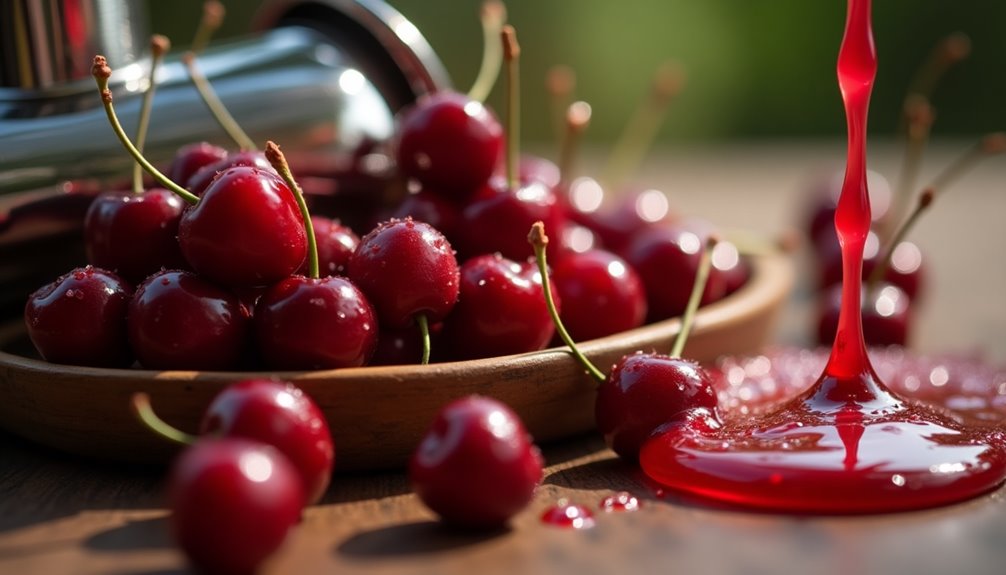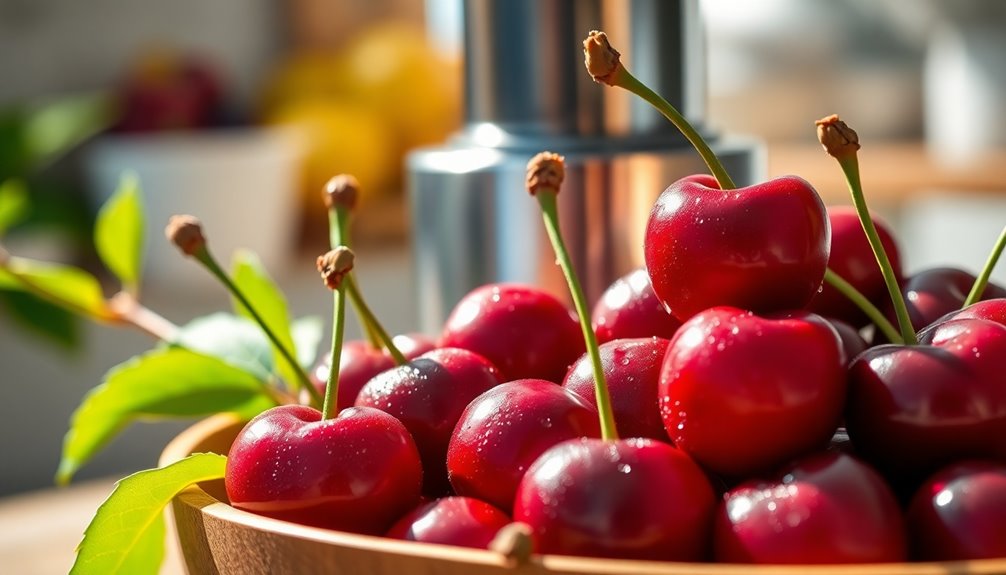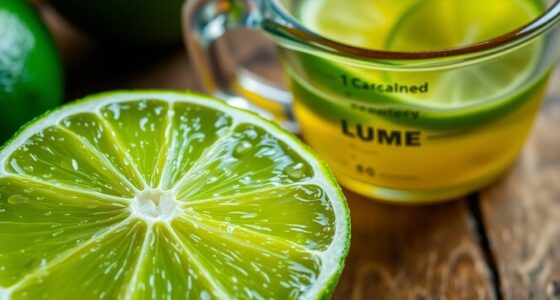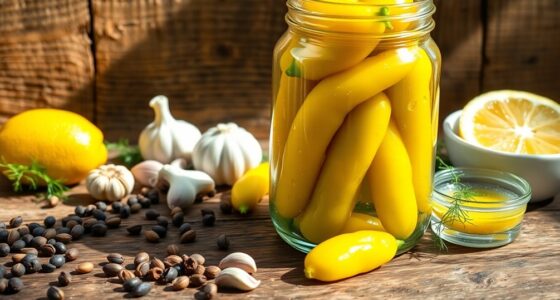To juice cherries, start by washing fresh or frozen organic cherries and removing the pits. You can use a juicer for the best results, or blend the pitted cherries and strain the puree through a mesh strainer. If you don't have a juicer, try hand-mashing them and pressing through a sieve. Homemade cherry juice is nutritious and lasts 1-2 days in the fridge or up to 3 months if frozen. There's more to discover about enhancing your juicing experience!
Key Takeaways
- Start with fresh or frozen organic cherries, ensuring to wash them thoroughly and remove pits to avoid juicer damage.
- Use a juicer, preferably a cold-press model, for the most efficient juice extraction.
- Alternatively, blend pitted cherries and strain using a mesh strainer or nut milk bag for homemade juice.
- Store homemade cherry juice in the fridge for 1-2 days or freeze in airtight containers for up to 3 months.
- Enjoy the health benefits of cherry juice, rich in vitamin C and antioxidants, by incorporating it into your diet regularly.

Juicing cherries is a delicious way to enjoy their sweet, tangy flavor and reap their health benefits. If you're looking for a refreshing drink that's packed with vitamin C and antioxidants, homemade cherry juice is the perfect choice. You can easily make your own cherry juice using fresh or frozen organic cherries, and the process is straightforward. Let's walk through the steps to create a delightful cherry juice recipe that you can savor.
First things first, you need to prepare your cherries. Whether you're using fresh cherries or frozen ones, it's essential to remove the pits before you start juicing. Pitting cherries can be a bit tedious, but it's crucial since juicing with pits can damage your juicer. You can use a paring knife or a metal skewer to remove the pits efficiently. If you're short on time, consider buying pitted cherries, but keep in mind that fresh, organic cherries will yield the best flavor and health benefits.
Once your cherries are pitted, you can choose a juicing method that works best for you. You have a few options here: if you have a juicer, that's a great way to go. Cold-press juicers, like the Omega VSJ843, are particularly effective for cherries, as they extract more juice with less pulp, giving you a smoother result.
If you don't have a juicer, don't worry! You can also use a blender. Just blend the pitted cherries until they're pureed, then pour the mixture through a mesh strainer or nut milk bag to separate the juice from the pulp. Another method is to mash the cherries by hand and press them through a sieve. No matter which method you choose, you'll end up with delicious homemade cherry juice.
Before you enjoy your refreshing drink, remember that proper storage is key. Homemade cherry juice can be kept in the fridge for 1-2 days, but if you want to preserve it for a longer period, freezing is the way to go. You can freeze your juice in ice cube trays or airtight containers, and it'll last for up to 3 months. This way, you can enjoy the health benefits of cherries anytime.
Don't forget to wash your cherries thoroughly before juicing, especially if you're using non-organic cherries. Cherries are on the Dirty Dozen list due to their higher pesticide levels, so rinsing them well helps reduce any pesticide residue. By choosing organic cherries whenever possible, you can make the most of your juice while ensuring it's as healthy as possible.
Now that you know how to juice cherries, it's time to get started. Gather your fresh cherries, select your juicing method, and enjoy the process of creating a delicious, antioxidant-rich drink that you and your family will love!
Frequently Asked Questions
How to Get the Juice Out of Cherries?
To get juice out of cherries, you'll want to start by washing them thoroughly and removing the pits.
You can slice them in half or use a skewer for easier pit removal.
Next, choose your method: a juicer will give you the most juice, while a blender requires straining.
If you prefer mashing, press the cherries through a strainer or nut milk bag.
Enjoy your fresh cherry juice right away or store it for later!
Can You Juice Cherries With the Pits?
Juicing cherries with pits? That's like trying to swim with a brick tied to your ankle—it's just not a good idea!
While it's technically possible, you'll end up with a bitter flavor and risk damaging your juicer. Pits can clog the machine and ruin the juice's taste.
To get the best flavor and keep your juicer happy, you should definitely remove the pits before you start juicing those delicious cherries.
Are Cherries Good for Juicing?
Yes, cherries are great for juicing! They're loaded with antioxidants and natural sugars, making your juice both nutritious and delicious.
You'll enjoy the refreshing flavor while benefiting from their anti-inflammatory properties, which can help with conditions like arthritis.
Opting for organic cherries minimizes pesticide exposure, too.
Plus, juicing preserves essential vitamins and minerals, so you're getting a healthy beverage.
Give it a try; you won't be disappointed!
Do You Use Hot or Cold Water to Remove Cherry Juice Stains?
Cherry juice stains can feel like a disaster waiting to happen!
You should definitely use cold water to remove those pesky stains. Rinse the fabric immediately with cold water to dilute the juice.
If the stain's stubborn, mix cold water with dish soap or laundry detergent and apply it directly.
After treating, launder in cold water, and always check the stain's gone before drying to avoid setting it permanently.
Conclusion
Now that you know how to juice cherries, imagine the vibrant, sweet nectar waiting just for you. Picture the deep red liquid filling your glass, its aroma wafting through the air. But wait—before you take that first sip, consider the burst of flavor and health benefits that await. Are you ready to experience the refreshing delight of homemade cherry juice? Don't hesitate; grab those cherries and start your juicing journey—you won't regret it!
Cindy thoroughly researches juicing trends, techniques, and recipes to provide readers with practical advice and inspiration. Her writing style is accessible, engaging, and designed to make complex concepts easy to understand. Cindy’s dedication to promoting the advantages of juicing shines through her work, empowering readers to make positive changes in their lives through the simple act of juicing.
















